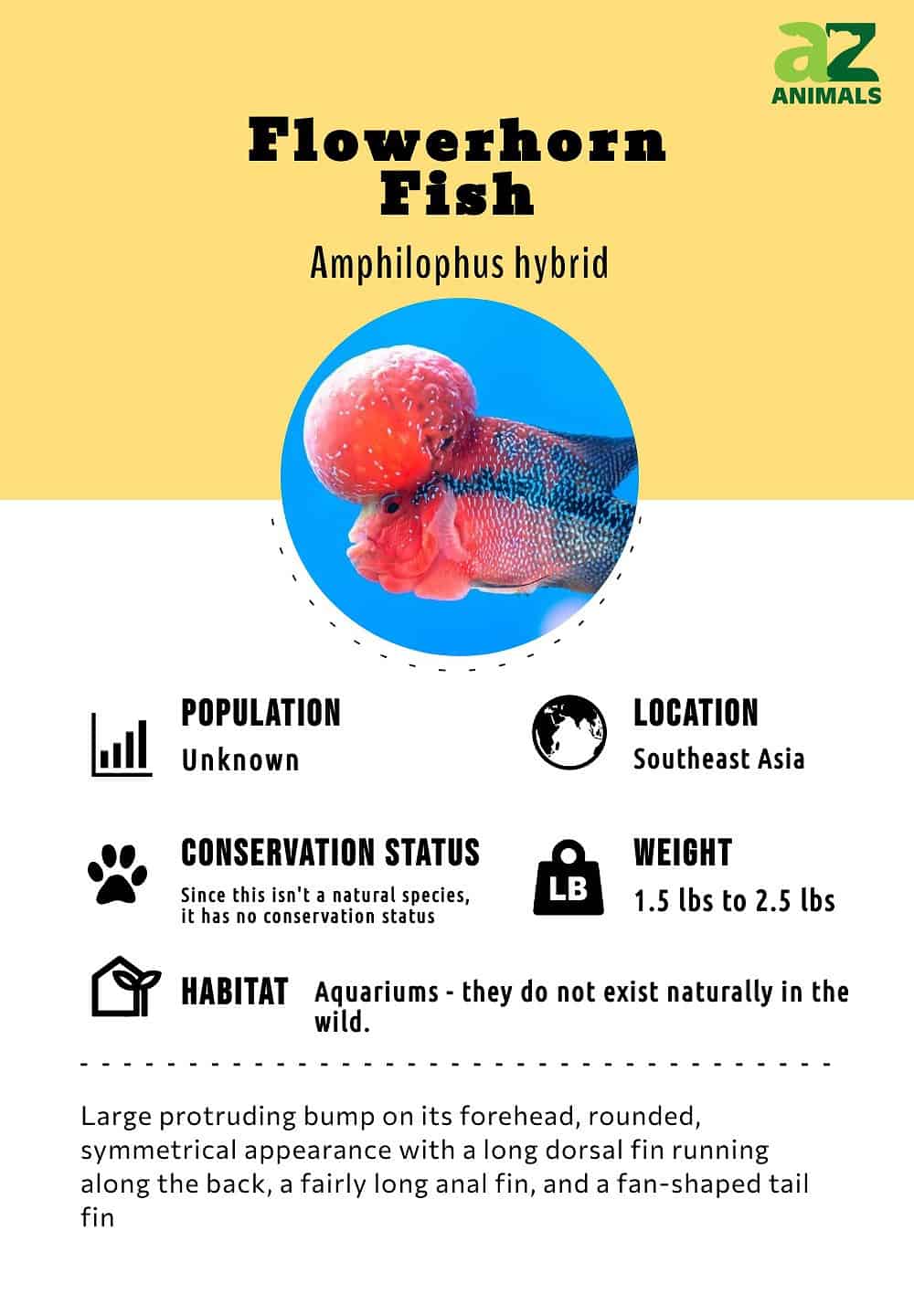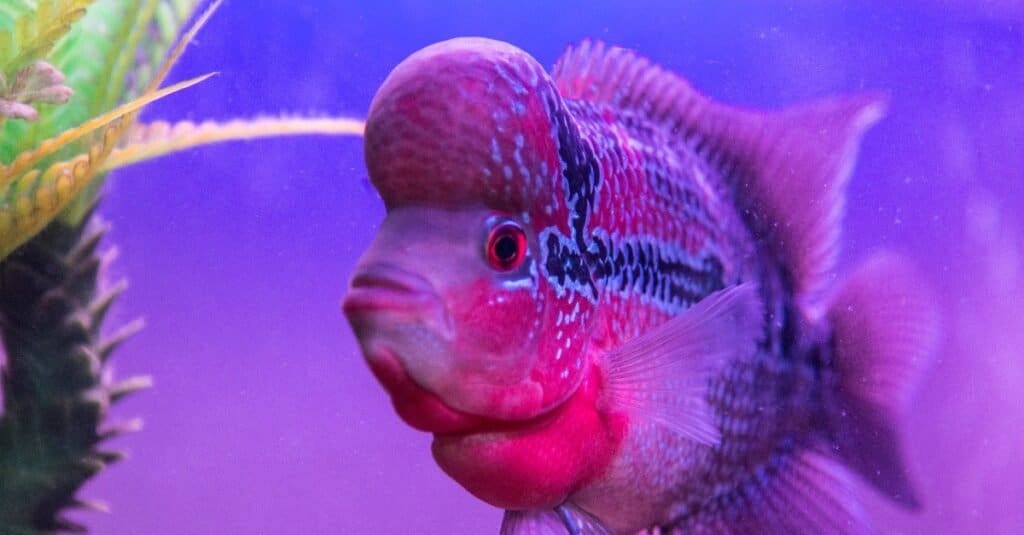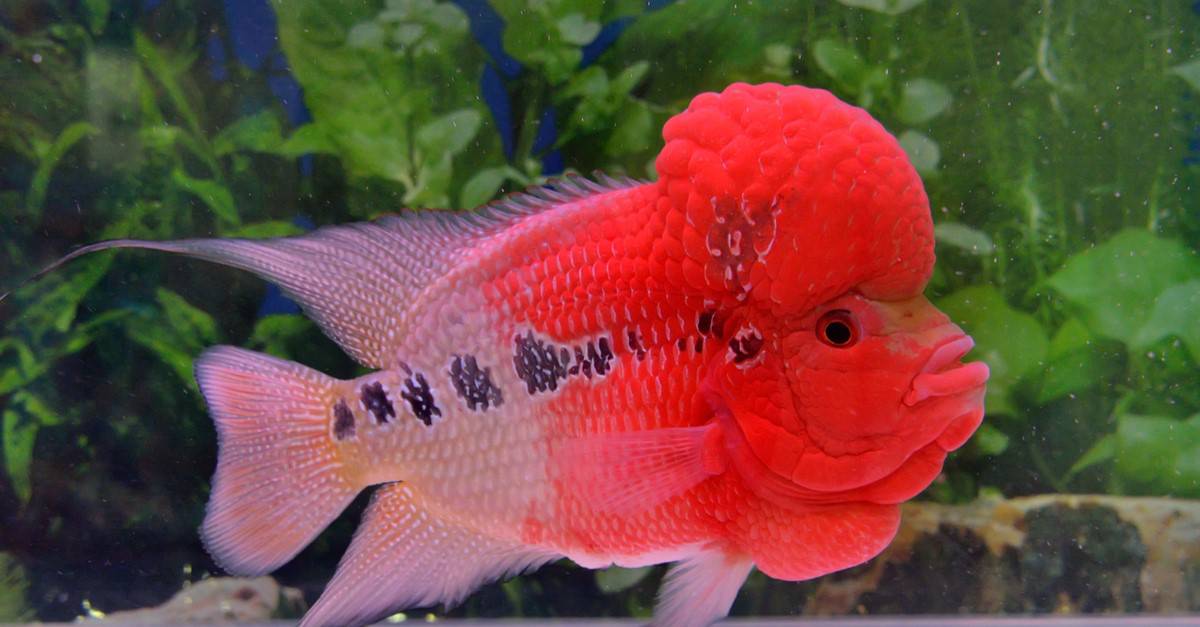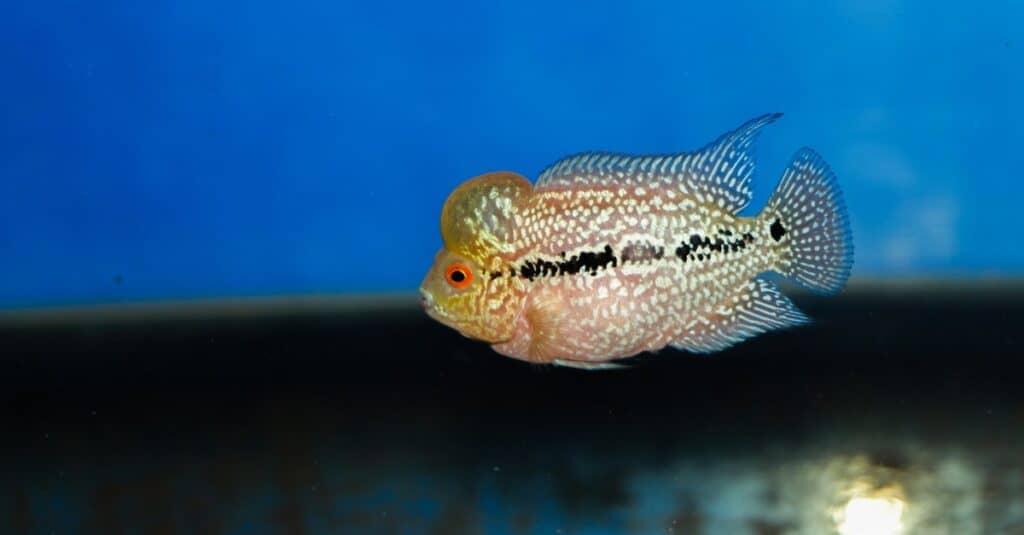Flowerhorn Fish
The Flowerhorn fish is an artificial species; it does not exist naturally
Advertisement
Flowerhorn Fish Scientific Classification
Read our Complete Guide to Classification of Animals.
Flowerhorn Fish Conservation Status
Flowerhorn Fish Facts
- Prey
- Shrimp, worms, insects, and plant matter
- Name Of Young
- Larvae and fry
- Group Behavior
- Solitary
- Fun Fact
- The Flowerhorn fish is an artificial species; it does not exist naturally
- Estimated Population Size
- Unknown
- Biggest Threat
- None
- Most Distinctive Feature
- The bulbous skin on the forehead
- Other Name(s)
- Flowerhorn Cichlid
- Gestation Period
- 1 - 2 weeks
- Average Spawn Size
- Up to 1,000 at a time
- Habitat
- Freshwater
- Predators
- Larger fish
- Diet
- Omnivore
- Type
- Ray-finned fish
- Common Name
- Flowerhorn Fish
- Number Of Species
- 1
- Location
- Worldwide
Flowerhorn Fish Physical Characteristics
- Color
- Red
- Blue
- Black
- White
- Green
- Orange
- Skin Type
- Scales
- Lifespan
- Up to 12 years
- Weight
- About 0.5kg (1lb)
- Length
- Up to 40cm (16in)
- Age of Sexual Maturity
- Up to a year
- Age of Weaning
- A few days
View all of the Flowerhorn Fish images!
The Flowerhorn fish, also known as the Flowerhorn cichlid, is an artificial creation of human breeders, thought to originate from Southeast Asia in the 1990s.
This unique freshwater hybrid was produced from crosses between several different types of cichlids, including blood parrots, red devils, and three spot cichlids (or the trimac). Today there are more than a dozen different varieties of the Flowerhorn, but the Zhen Zhu, Golden Monkey, and Kamfa are among the most popular, each one varying in its colors, markings, and shape. While purely human creation, some owners have discarded them back into the wild, where they can aggressively out-compete native fish (though many of the males are sterile). For this reason, it is considered to be an invasive species in many countries.
See all of our expert product reviews.
3 Incredible Flowerhorn Fish Facts!
- Flowerhorn fish are sometimes considered to be signs of fortune, luck, health, and prosperity by collectors.
- Flowerhorn fish will change colors throughout their lives. They will gradually gain their full colors upon reaching maturity, and then the colors slowly fade as they begin to age. Certain plant-based foods (like those containing xanthophyll) can affect their colors as well. Drastic color changes, especially the sudden appearance of pale or dark markings and spots could signify stress, poor environmental conditions, or even disease.
- Some strains have a white to dark line of spots running across the side of the body. These markings are called a pearling or a flower line.

Scientific Name

Beautiful Flowerhorn cichlid fish are not recognized as a distinct species because they were created by humans.
©iStock.com/Khoblaun
Because it was artificially created by humans, the Flowerhorn is not recognized as a distinct species and is given the name Amphilophus hybrid. It was bred from several other hybrid cichlids, a family of freshwater tropical fish distributed throughout the world. Cichlids are very popular with breeders and aquarium owners for their incredible diversity of bright, garish colors and complex body markings.
Types Of
Although this species is not recognized as a distinct species because it has been cross-bred by hobbyists numerous times with various species of Central American cichlid species, there are still four main varietals, in addition to the numerous others. None of these entire species is a native species found in the wild, even though they may currently be found there now, they are not endemic to these areas. These types are:
- Zhen zhu flowerhorn fish
- Golden monkey flowerhorn fish
- Kamfa flowerhorn fish
- Golden base flowerhorn fish
While it is hard to verify, it is believed that these fish are derived from a cross of the Blood Parrot Cichlid and another hybrid called the Red Devil Cichlid.
Health and Entertainment for your Flowerhorn Fish
See all of our expert product reviews.
Appearance

Flowerhorn cichlid fish can measure anywhere up to 16 inches in size and is characterized by the large protruding bump on its forehead.
©luis2499/Shutterstock.com
The Flowerhorn cichlid is a medium-sized fish, normally measuring anywhere up to 16 inches in size. It is characterized by a rounded, symmetrical appearance with a long dorsal fin running along the back, a fairly long anal fin, and a fan-shaped tail fin. These fish also have two sets of teeth: the normal set in the mouth and a secondary set in the throat (known as pharyngeal teeth) that help to grind up food.
By far the most prominent characteristic, however, is the large protruding bump on the forehead (known as the nuchal hump), composed of a bulbous soft tissue of fat or gel. The purpose of this bump isn’t fully understood, but it may have something to do with sex recognition in many cichlid species. Depending on the strain, this animal can come in many different colors; usually a white base with orange, red, or black markings running sideways along the body. Blue and green are common colors as well. Males are fairly easy to recognize. They tend to be larger than females with more vivid colors and a bigger forehead bump.
Behavior

The Flowerhorn will most likely require a large tank with a lot of room for swimming.
©Lucas Photo/Shutterstock.com
Although bred in captivity, the Flowerhorn fish is a wild tropical species with very particular needs. It will probably require a large tank with plenty of space to swim around in; some experts claim it will need at least 70 gallons, but it might be necessary to go as large as 100 gallons for a single fish. The water should be consistently maintained at a temperature of 80 to 86 degrees Fahrenheit and a pH of 7.0 to 8.0. A standard canister filter with a moderate flow rate will keep the tank clean and healthy.
The tank should be filled with a soft substrate and only a few minor decorations. The Flowerhorn has a tendency to dig around in the dirt and root up plants. A bit of driftwood and a few medium-sized rocks should be sufficient to properly simulate a “natural” environment.
The Flowerhorn appears to be a curious fish that likes to roam around and investigate its surroundings. There are even anecdotal reports that the Flowerhorn fish likes to interact with its owner and can recognize a person’s face. However, depending on the breed, they can be a bit territorial and do not often tolerate the presence of another fish in the tank.
Flowerhorns are usually quite happy on their own, and pairing them with another fish can result in one attacking the other. If you do plan on getting a tank mate, then you might want to try a medium-sized fish like a pleco, an Oscar fish, or a silver Arowana that also tolerates similar environmental conditions. Do not pair them with smaller fish that lack the ability to stand their ground against the Flowerhorn. In order to ensure that there’s plenty of room for two fish, you will probably need a tank of around 150 gallons.
Habitat

This Cichlid does not exist naturally in the wild but was developed by breeders in Asia.
©nicefishes/Shutterstock.com
The Flowerhorn fish does not exist naturally in the wild. It was gradually developed by breeders in Malaysia, Thailand, and Taiwan, each one crossing it with a new strain or species to produce entirely novel types. Since the 1990s, it has become very popular with aquarium hobbyists throughout East Asia. It also gained a small but eager following in Europe and the United States. However, because of irresponsible disposal, this fish sometimes appears in natural habitats around Southeast Asia, displacing native species. A few countries may actually ban their import.
Predators And Threats
As a popular aquarium fish, the Flowerhorn faces no serious threats in captivity. However, the quality of their care will have a significant impact on their lifespan. A poorly cared for fish will be more likely to develop health conditions. One of the most common problems is called hole-in-the-head disease. This self-explanatory condition is often caused by poor water quality and the presence of carbon. Moreover, white spots around the gills and body could be a sign of a freshwater parasite called ich. Knowing the signs is the first step toward treating your fish.
What Eats The Flowerhorn Fish?
In captivity, the Flowerhorn obviously has no natural predators. But In the wild, it can be preyed upon by larger fish.
What Does The Flowerhorn Fish Eat?
The Flowerhorn fish can be described best as an opportunistic omnivore. It is not particularly picky about what kinds of foods it eats. In captivity, plant-based foods in any form (including pellets) should compose part of its diet. It particularly enjoys peas, lettuce, and spinach. This should be supplemented with a protein-rich diet consisting of worms, shrimp, crickets, grasshoppers, and other insects. Owners will need to feed them around two or three times a day. Flowerhorns are voracious eaters and will pretty much consume almost anything you feed them, so try to limit their caloric intake a little to prevent weight gain.
Reproduction And Life Cycle

Baby flowerhorn fish may be sold at the age of 3 or 4 months when it reaches a few inches large.
©luis2499/Shutterstock.com
The Flowerhorn fish has a reputation for being a little finicky to breed in captivity. Males can be aggressive during the courtship process and may sometimes attack the female. Even if they do mate with the female, some of them are completely infertile due to the hybridization process. If you plan to breed Flowerhorns, then reproduction should ideally occur in a separate tank from the main one. Some breeders like to place a divider between the pair with enough water flow to help hormones pass through. Females will lay up to a thousand eggs per month, whether or not a male is actually present.
Once they’ve properly mated, the male (and sometimes the female as well) will stand guard over the eggs until they’re ready to hatch about one or two weeks later. Paternal investment usually ends when the baby fry starts to swim, usually a few days after hatch. By the time they’ve consumed all the yolk from their eggs, owners will need to feed the baby fry up to 10 times per day for the first few months of their lives. At three or four months of age, the baby fry reaches a few inches large and is usually sold at that point. Some of the larger breeds of Flowerhorns can survive up to 12 years in captivity, providing the owner with plenty of enjoyment and entertainment.
Population
The number of Flowerhorn fish worldwide is unknown. Since this isn’t a natural species, the IUCN Red List (or any other conservation organization) hasn’t assigned it a conservation status.
View all 91 animals that start with FFlowerhorn Fish FAQs (Frequently Asked Questions)
Are Flowerhorn fishes carnivores, herbivores, or omnivores?
The Flowerhorn is an omnivore. It needs a well-balanced diet consisting of plants and meat.
What do Flowerhorn fish eat?
In captivity, the Flowerhorn should be fed a plant-based diet, which can come in any form, including pellets. This should be supplemented with worms, shrimp, crickets, grasshoppers, and other insects.
What is special about Flowerhorn fish?
The Flowerhorn fish is an artificially bred species, created by people for its beauty and appearance. The very first Flowerhorn was developed from the blood parrot cichlid, which itself is a hybrid between a few Central American cichlid species. These original stocks are generally known as the Louhan. It was then bred with several other types of cichlids to produce various types of Flowerhorns. The Kamfa was developed directly from the Louhan; it is characterized by a square body, a particularly prominent forehead bump, white or yellow eyes, and a black flowering pattern along the side. The Zhen Zhu has red protruding eyes, a more rounded tail, and yellow or tan colors with an iridescent flowering pattern. The Golden Monkey, characterized by vivid colors and black lines down the middle, is an original Louhan-based fish; as a result, it’s quite rare and expensive.
What is the cost of flowerhorn fish?
The price for a common Flowerhorn strain could be as little as $30; the cost of care will probably be more expensive than the fish itself. However, some people will pay a very high price for particularly rare and valuable strains such as the Golden Monkey, sometimes hundreds or even a thousand dollars. The Flowerhorn hobby can be just as serious and hardcore as any dog breeding.
Can Flowerhorn fish live with other fish?
The Flowerhorn is generally known for being aggressive and territorial. They might not accept other fish in their tanks, even members of the same species. If you plan to house multiple fish, then you should try to keep them separate from each other. However, this can be difficult, because the Flowerhorn does like to roam and explore.
Are Flowerhorn fish good pets?
That depends on what you want from your pet. They can be a little finicky and territorial with some very specific care requirements, but they’re also quite beautiful and curious with an excellent lifespan. They were specially bred to appeal to hobbyists.
Where can I buy Flowerhorn fish?
If you’re not picky about the type of Flowerhorn, then one can be acquired from a local pet store for a very reasonable price. However, some strains can only be found at an exotic fish store.
Thank you for reading! Have some feedback for us? Contact the AZ Animals editorial team.
Sources
- Aquarium Source, Available here: https://www.aquariumsource.com/flowerhorn-cichlid/
- Vivo Fish, Available here: https://www.vivofish.com/flowerhorn-cichlid/
- Springer Link, Available here: https://link.springer.com/article/10.1007/s10228-018-0614-y

















